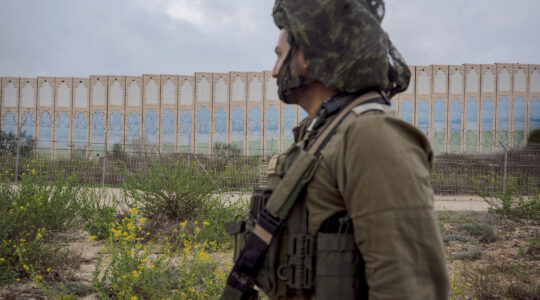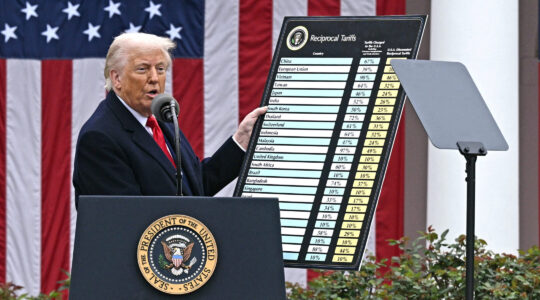
The Aleppo pine, also known as the Jerusalem pine, was chosen in the 1930s as the ideal tree for planting because of its ability to grow quickly and soar high. (Yagil Osem / Israel Ministry of Agriculture)
TEL AVIV (JTA) — From leafy eucalyptus trees lapping the shores of the Sea of Galilee to date palms in the desert to pine and oak trees in the North — many of which were destroyed in the Carmel’s forest fire last month — Israel will celebrate trees on Tu b’Shvat.
The holiday, which for centuries was a rather obscure festival mentioned in the Mishnah as the new year for trees, was revived by the early Zionists as part of their back-to-the-land ethos. It’s now a highlight of the Israeli national calendar, with tens of thousands of Israelis, most of them schoolchildren, pouring out across the country to plant saplings in celebration of the Jewish Arbor Day.
But this year, in wake of the Carmel Forest fire that killed 44 and consumed some 5 million trees and 12,000 acres of land, a growing understanding has taken root that mass replanting of trees is not the way to go. At least not right now.
“Planting is still important, but in many cases we have to make a kind of change in our consciousness,” said Yisrael Tauber, director of forest management for the Jewish National Fund-Keren Kayemeth LeIsrael. “It’s not just planting, but also natural regeneration of forests, and the managing of that natural regeneration that is key.”
The strategy after the fire has cast a spotlight on Israel’s longtime rush to make the Holy Land green, which for decades was embraced as Gospel (or, more accurately, Torah from Sinai) by both Diaspora and Israeli Jews. The question now is not how fast trees can be planted but whether and which trees should go in the ground, and how Israel should plan its ecological future.
In the state’s early years there was a rush to plant pines, considered among the only trees that could survive and grow quickly on the bare, rocky ground that covers much of Israel, Tauber said.
“But now we are in a second, new phase,” he noted. “We are now building sustainable forestry after these pioneering pines did a wonderful job for the first generation.”
With a dry climate similar to that of California or Spain, Israel is a natural home for relatively short trees that need little water. Some, like acacias, can go for months without even a drop.
For centuries the area was covered in a patchwork of squat, dense low-lying forest, especially in the native woodland areas of the Carmel, Galilee and the Judean hills. But by the time the early Zionist settlers arrived, much of the forestland had been depleted, used over the years as firewood, building material, grazing land for goats and sheep, and even train tracks in the Ottoman era.
“When people came to the land it looked like desert,” said Yagil Osem, a forestry expert at Israel’s Agriculture Ministry. “Part of the Zionist ethos was to rehabilitate the view.”
After several failed attempts with other species, the Aleppo pine (also known as the Jerusalem pine) was chosen in the 1930s as the ideal tree for planting. Selected for its heartiness in arid soil and ability to grow quickly and soar high into the sky, the tree created the kind of forests with room for hiking and recreation that the Jews living in prestate Palestine knew of from Europe.
Today that first generation of pines is aging, demanding more water and more prone to problems like pests, disease and fire, according to Osem. Forests that are almost exclusively pine planted of the same age and variety are especially vulnerable, he said.
The planting paradigm began to shift by the 1980s with a growing awareness of the importance of forest diversification. Other native varieties began to be introduced, including carob, pistachio, oak and other varieties of pine. The common oak is seen throughout the country’s forests as well as in the Golan Heights.
Now the goal is to have as many “mixed” forests as possible with a focus on sustainable management, JNF officials say.
Among the non-native pine species introduced in recent years to Israel are the Brutia, a variety that grows in Turkey and Cyprus and is known for being more pest resistant, and the Stone pine (also known as the nut pine), which produces pine nuts. The Stone pine is thought originally to have been brought to the Holy Land by the Romans, who cooked with pine nuts.
In a land where even trees have become politicized as part of the Israeli-Palestinian conflict, the pine tree has become emblematic of a renewed Jewish presence here, while the olive tree has become a symbol of the Palestinians’ ties to the land. Of course, in biblical times the Jews were also known for tending olive trees.
The olive tree’s deep historical roots date back some 10,000 years as this agricultural commodity took on important regional economic importance.
Other prominent trees in Israel include the carob, which grows throughout the country. Originally from Africa, it is a relatively late local species, and like other successful trees here it needs little water to thrive.
A cousin to the carob is the almond tree, whose white blossoms are harbingers of Tu b’Shvat’s arrival. It grows both at higher elevations and in the transition zone between the coastal Mediterranean plain and the desert. In its wild form its almonds are inedible, so it’s the domesticated variety that provides the almonds commonly eaten on Tu b’Shvat.
Fig trees also are native and grow naturally near Israel’s rivers and streams. Cypress trees, which can live for hundreds of years, also are part of the Israeli landscape, most commonly seen in the North. Experts think the species may be native but that it disappeared over the centuries by locals attracted to the wood produced by its attractive, straight shape. The cypresses of today were brought from other parts of the Mediterranean and planted here. They are used often in landscaping and, because of their candle-like appearance, are planted frequently in the country’s cemeteries.
Date palms, located in the Arava Desert and the Jordan Valley, grow naturally along desert streams, but it’s not clear whether such trees are native or the result of the casual tossing of their seeds by snacking Bedouin nomads.
Citrus trees, specifically the Jaffa orange, are cultivated in groves along the coastal plain, and in the 1950s and ‘60s they represented something of an unofficial national symbol. But with the shrinking of Israel’s agriculture industry, many of the groves have been replaced by homes and office buildings.
Israeli citrus — oranges, lemons, tangerines and pomellos — are still exported in relatively large quantities, especially to Europe but even as far afield as Japan. It is thought that the first orange varieties were brought to the region by Arab traders who brought them from China and India. The introduction of more commercially successful avocado, mango and banana plantations have edged out many of the remaining citrus groves in Israel.
Much of the tree-planting energy today in Israel goes to the northern Negev Desert, where trees are being planted not on the grand level of the forests in the North but in small orchards and green areas as sources of shade and recreation. Their growth is assisted with collected rainwater by planting the trees in small depressions where the water can pool.
Osem says these Israeli rainwater collection techniques are being copied by countries suffering from desertification in parts of Africa and Asia.
It’s one way the spirit of Tu b’Shvat is going global.
JTA has documented Jewish history in real-time for over a century. Keep our journalism strong by joining us in supporting independent, award-winning reporting.





